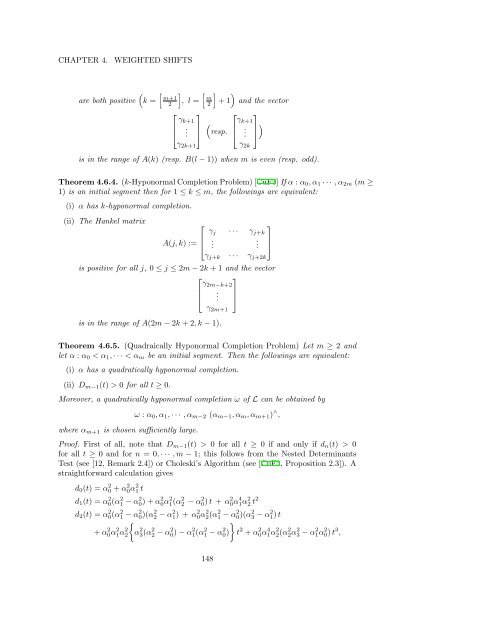Woo Young Lee Lecture Notes on Operator Theory
Woo Young Lee Lecture Notes on Operator Theory
Woo Young Lee Lecture Notes on Operator Theory
You also want an ePaper? Increase the reach of your titles
YUMPU automatically turns print PDFs into web optimized ePapers that Google loves.
CHAPTER 4.<br />
WEIGHTED SHIFTS<br />
are both positive<br />
( [<br />
k =<br />
] [<br />
m+1<br />
2<br />
, l =<br />
⎡ ⎤<br />
γ k+1<br />
⎢<br />
⎣<br />
⎥<br />
. ⎦<br />
γ 2k+1<br />
] )<br />
m<br />
2<br />
+ 1 and the vector<br />
⎡ ⎤<br />
(<br />
γ k+1<br />
)<br />
⎢<br />
resp. ⎣<br />
⎥<br />
. ⎦<br />
γ 2k<br />
is in the range of A(k) (resp. B(l − 1)) when m is even (resp. odd).<br />
Theorem 4.6.4. (k-Hyp<strong>on</strong>ormal Completi<strong>on</strong> Problem) [CuF3] If α : α 0 , α 1 · · · , α 2m (m ≥<br />
1) is an initial segment then for 1 ≤ k ≤ m, the followings are equivalent:<br />
(i) α has k-hyp<strong>on</strong>ormal completi<strong>on</strong>.<br />
(ii) The Hankel matrix<br />
⎡<br />
⎤<br />
γ j · · · γ j+k<br />
⎢<br />
A(j, k) :=<br />
⎥<br />
⎣ .<br />
. ⎦<br />
γ j+k · · · γ j+2k<br />
is positive for all j, 0 ≤ j ≤ 2m − 2k + 1 and the vector<br />
⎡ ⎤<br />
⎢<br />
⎣<br />
γ 2m−k+2<br />
.<br />
γ 2m+1<br />
is in the range of A(2m − 2k + 2, k − 1).<br />
Theorem 4.6.5. (Quadraically Hyp<strong>on</strong>ormal Completi<strong>on</strong> Problem) Let m ≥ 2 and<br />
let α : α 0 < α 1 , · · · < α m be an initial segment. Then the followings are equivalent:<br />
(i) α has a quadratically hyp<strong>on</strong>ormal completi<strong>on</strong>.<br />
(ii) D m−1 (t) > 0 for all t ≥ 0.<br />
Moreover, a quadratically hyp<strong>on</strong>ormal completi<strong>on</strong> ω of L can be obtained by<br />
where α m+1 is chosen sufficiently large.<br />
⎥<br />
⎦<br />
ω : α 0 , α 1 , · · · , α m−2 (α m−1 , α m , α m+1 ) ∧ ,<br />
Proof. First of all, note that D m−1 (t) > 0 for all t ≥ 0 if and <strong>on</strong>ly if d n (t) > 0<br />
for all t ≥ 0 and for n = 0, · · · , m − 1; this follows from the Nested Determinants<br />
Test (see [12, Remark 2.4]) or Choleski’s Algorithm (see [CuF2, Propositi<strong>on</strong> 2.3]). A<br />
straightforward calculati<strong>on</strong> gives<br />
d 0 (t) = α 2 0 + α 2 0α 2 1 t<br />
d 1 (t) = α 2 0(α 2 1 − α 2 0) + α 2 0α 2 1(α 2 2 − α 2 0) t + α 2 0α 4 1α 2 2 t 2<br />
d 2 (t) = α0(α 2 1 2 − α0)(α 2 2 2 − α1) 2 + α0α 2 2(α 2 1 2 − α0)(α 2 3 2 − α1) 2 t<br />
{<br />
}<br />
+ α0α 2 1α 2 2<br />
2 α3(α 2 2 2 − α0) 2 − α1(α 2 1 2 − α0)<br />
2 t 2 + α0α 2 1α 4 2(α 2 2α 2 3 2 − α1α 2 0) 2 t 3 ,<br />
148













